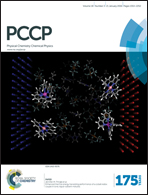Nanostring-cluster hierarchical structured Bi2O3: synthesis, evolution and application in biosensing
Abstract
In the present study, a simple strategy was developed to fabricate a new Bi2O3 nanostring-cluster hierarchical structure. Precursor microrods composed of Bi(C2O4)OH were initially grown under hydrothermal conditions. After calcination in air, Bi(C2O4)OH microrods were carved into unique string-cluster structures by the gas produced during the decomposition process. To explain the formation mechanism, the effects of pyrolysis temperature and time on the morphology of the as-prepared samples were investigated and are discussed in detail. It was discovered that the nanostring-cluster-structured Bi2O3 consists of thin nanoplatelet arrays, which is advantageous for glucose enzyme immobilization and for designing biosensors. The resulting Bi2O3 structure showed an excellent capability in the modification of electrode surfaces in biosensors by enhancing the sensitivity, with good specificity and response time. Such qualities of a biosensor are ideal characteristics for glucose sensing performance and allow for further explorations of its application in other fields.


 Please wait while we load your content...
Please wait while we load your content...